Legends of massive alligators have made people keep their eyes open in the swamps and rivers of Florida for centuries. These apex predators have little competition in their natural habitats outside of their own kind and humans.
We’ve all seen some pictures showing a monster gator or heard someone tell us about how impossibly huge what they saw was. But how big do alligators actually get? We’ll be detailing the certified records for the biggest alligators in Florida, what we know about them, and how humans impact alligators.
Florida Alligator Facts
Alligator Distribution
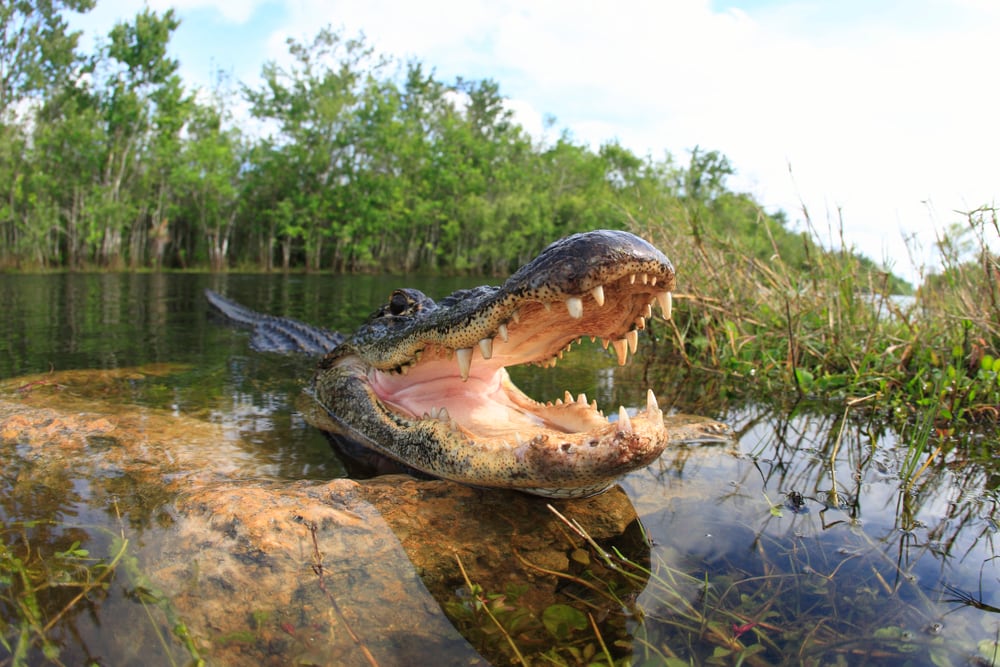
The American Alligator is only found in the Southeastern United States, in Florida, Georgia, Alabama, Mississippi, Louisiana, Texas, Arkansas, Oklahoma, And North and South Carolina.
For the most part, you’ll find them in freshwater lakes, slow-moving rivers, swamplands, and brackish wetlands. At one time, the American Alligator was considered an endangered species, but tight regulations have allowed the species to rebound into populations in the millions, leading to them no longer being considered threatened with extinction.
Alligator Sizes
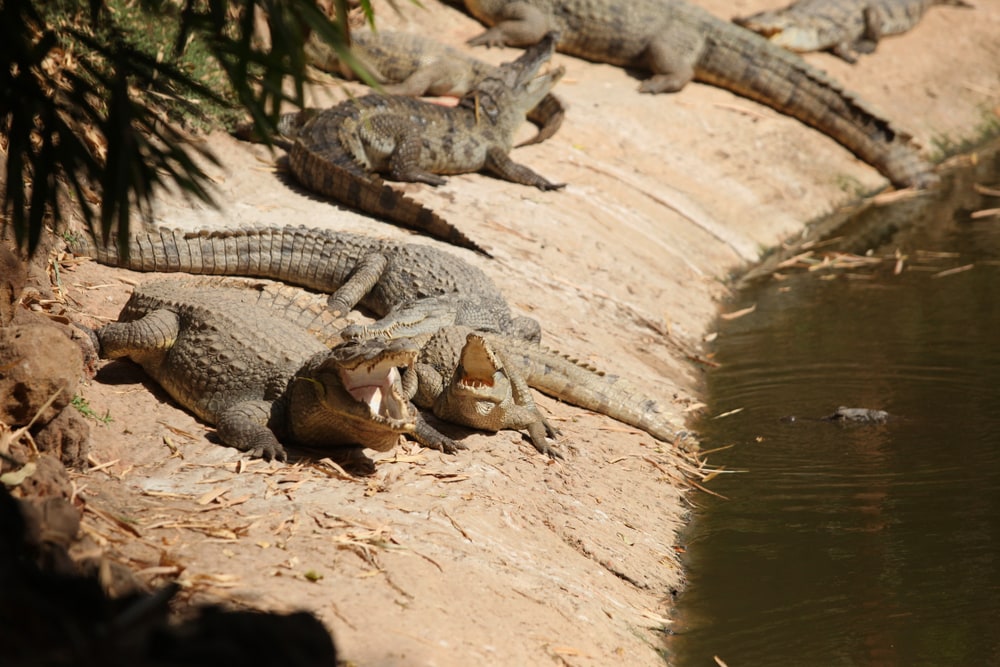
Typically, full-grown alligators average between ten and fifteen feet (3 to 4.6 meters) in length, with most peaking around eleven feet (3.35 meters) in length. Males grow larger than females, with females rarely growing to be over ten feet (3 meters) in length.
Despite myths that they grow during their entire lifetimes, alligators actually stop growing once they reach sexual maturity between ten and fifteen years old, their growth rate slows dramatically. By age forty, they stop growing entirely.
That’s not to say they can’t grow to huge sizes. Large specimens of male gators around fifteen feet (4.6 meters) can continue to grow heavier even after they stop gaining length. Documented cases of alligators weighing over 1,000 pounds (454 kilograms) are rare but entirely possible.
Alligator Life Cycle
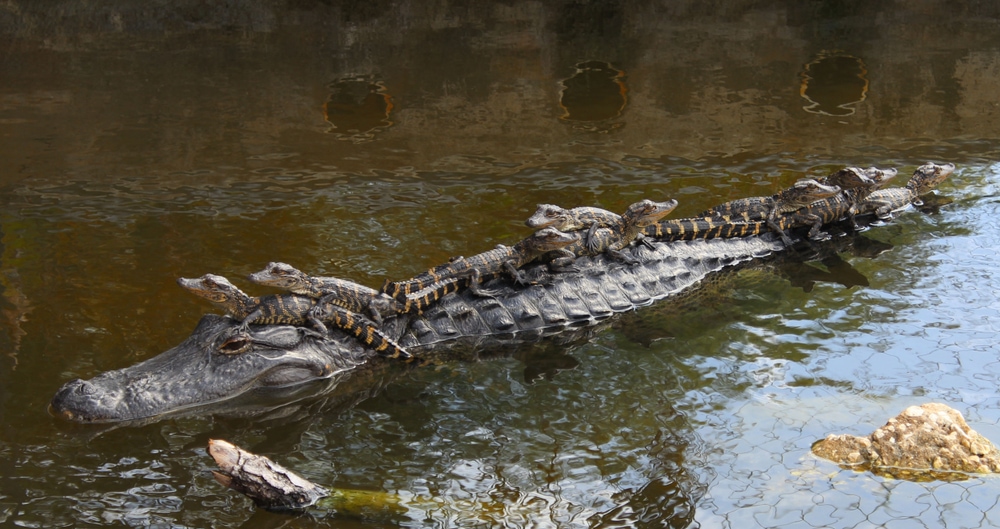
Alligators reach sexual maturity around the time they reach seven feet (2.1 meters) in length. For females, this can take around 10-15 years, while males reach this length in 8-12 years. Females build and guard nests and lay between 32 to 46 eggs at a time.
The survival rate for baby alligators is easily considered low. Of the eggs laid in a nest that dodges predators and flooding, about 24 will hatch. Only ten of those hatchlings survive beyond the first year of life, and only five of those ten reach maturity.
Most nests are directly along shorelines and are at risk of being wiped out by flooding. Female alligators can accidentally crush their clutches of eggs. The nests are also at risk of being raided by raccoons, and hogs, otters, bears, and some invasive lizards will also raid and eat the eggs.
Alligators are cannibals, with larger gators being a primary predator of juvenile gators. Wading birds, raccoons, otters, and fish are also threats to growing alligators. As adults, their largest threats are larger alligators who will fight with or feed on them, and humans who hunt them.
In the wild, alligators typically can live between 30 and 50 years of age but can live longer in captivity with some reaching seventy years of age.
Alligator Diet
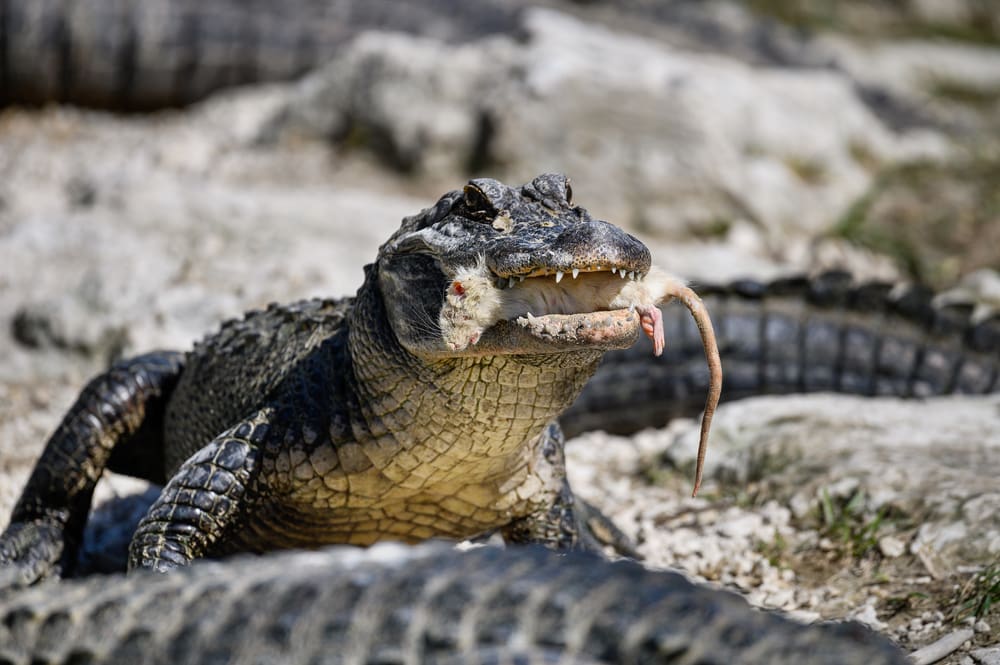
Alligators are opportunistic feeders that go after prey relative to their own size. Juvenile gators eat primarily small fish, insects, amphibians, and other invertebrates like crayfish. Adults eat everything, including fish, mammals, wading birds, snakes, and turtles.
Large enough alligators won’t be shy about taking prey as large as deer and wild hogs if the chance arises. They’re also one of the few species that regularly eat invasive snakes like Burmese pythons.
You may also like: Check Out the 7 Species of Majestic Owls in Florida: Complete with Images, Facts, and More!
10 Florida Alligators State Records
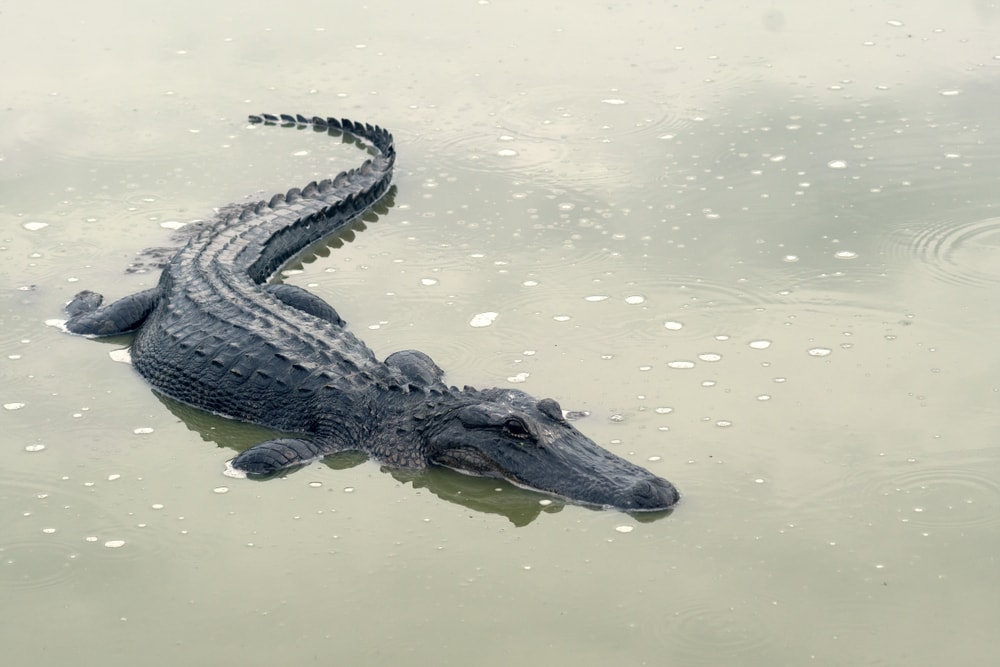
Trying to record records for the largest alligators is complicated. The Florida Fish and Wildlife Commission only recognizes records that have been measured and confirmed by state biologists.
You’ll find plenty of stories about excessively massive alligators if you even scratch the surface of what the biggest ones ever found were. The problem is that in the vast majority of these cases, the gator was only seen and no evidence was recorded.
For this list, we’ll only be using the alligators confirmed by the FWC and documented in this state record list. Even using the list, there are gaps in what we know about the capture.
After this quick list of the recognized state records, we’ll take a deeper look at news-worthy captures that haven’t been included in the FWC’s documented state record list.
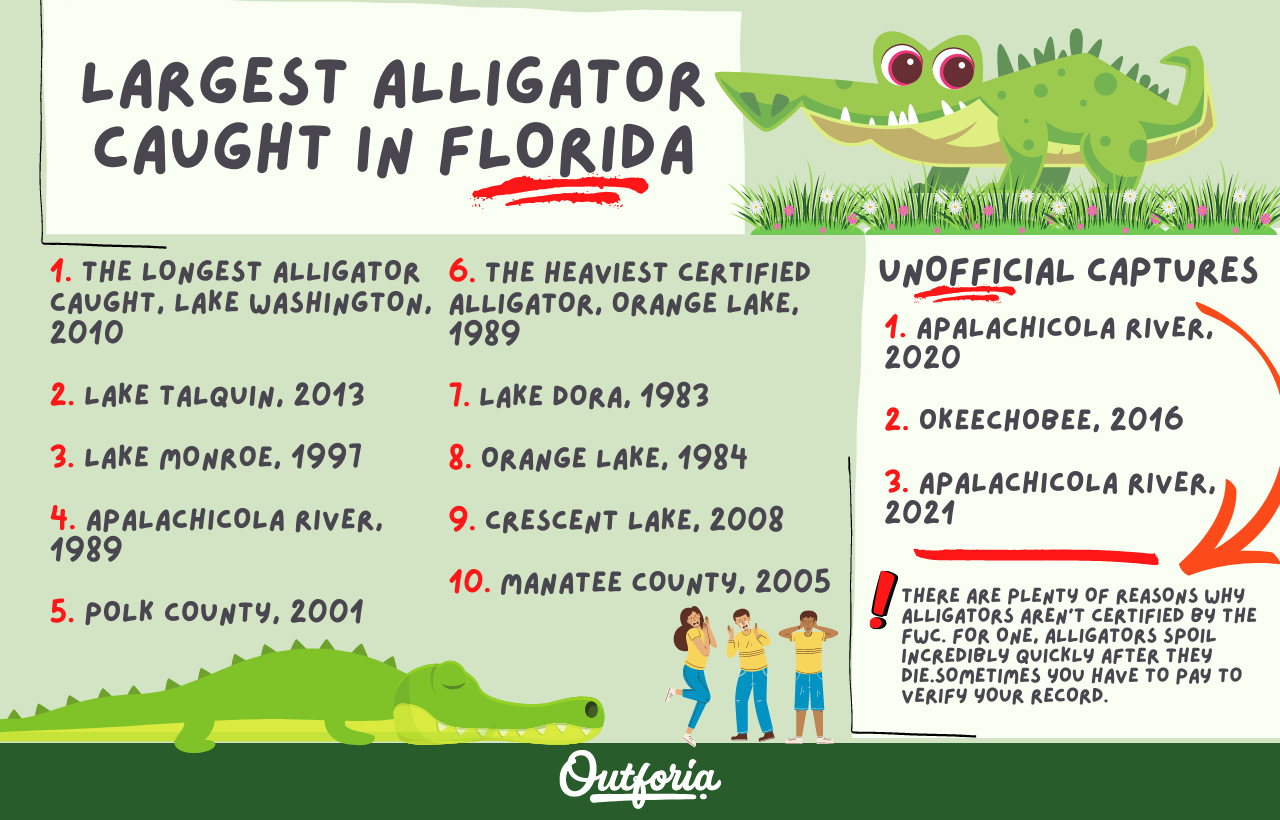
Share This Image On Your Site
<a href="https://outforia.com/largest-alligator-in-florida/"><img style="width:100%;" src="https://outforia.com/wp-content/uploads/2022/01/Largest-alligator-in-florida-infographics-01252022.png"></a><br>Largest Alligator In Florida Infographic by <a href="https://outforia.com">Outforia</a>1| Lake Washington, 2010
Caught in Lake Washington on November 1, 2010, the current record holder for longest alligator is a 14’ 3 ½” specimen. The gator was caught as part of the statewide harvest program and had a head that measured nearly two feet (0.6 meters) in length. It weighed 654 pounds (297 kilograms) when it was measured.
After being harpooned, the alligator tugged the boat and three hunters around the lake for forty-five minutes, and only then tired enough for them to tow it to shore.
2| Lake Talquin, 2013
The second-largest alligator certified by the FWC measured in at 14-feet (4 meters) 1-inch (203 centimeters). It was caught September 12, 2013, in Lake Talquin in the statewide alligator harvest program. No official weight was recorded for the gator, but it had a head length of 23 ½ inches (0.6 meters).
3| Lake Monroe, 1997
Just short of the second-largest alligator, an 800-pound (363 kilograms) alligator was caught in Lake Monroe on September 30, 1997. It was removed as part of the statewide nuisance alligator program that allows hunters to trap and remove alligators that pose a threat to people.
4| Apalachicola River, 1989
The Apalachicola River is home to some monstrous gators, so it’s no surprise that one made the top ten list. The 14-foot (4.3 meters) and 1/16-inch (0.16 centimeters) gator was caught June 5, 1989, and weighed in at 714 pounds (324 kilograms). It was also caught and removed as part of the nuisance gator harvesting program.
5| Polk County, 2001
On September 19, 2001, a nearly 14-foot (4.3 meters) alligator was captured on private land in Polk County. The large male weighed in at 880 pounds (399 kilograms) and had a head length of 22 ⅜ inches (0.57 centimeters).
6| Orange Lake, 1989
The record holder for heaviest alligator was a 13′-foot (4 meters) 10 ½-inch (26.7 centimeters) gator caught in Orange Lake. The beast was caught on April 17, 1989, and weighed a whopping 1,043 pounds (473 kilograms). The alligator was caught and removed as part of the statewide nuisance alligator harvest program.
7| Lake Dora, 1983
On March 31, 1983, hunters caught a 13-foot (3.96 meters) 9 1/4 -inch (23.5 centimeters) alligator in Lake Dora. It weighed in at 870 pounds (259 kilograms) and was caught as part of the statewide nuisance alligator harvest program.
8| Orange Lake, 1984
Another entry from Orange Lake, this 13-foot (3.96 meters) 8-inch (20 centimeters) gator was caught on September 25, 1984. The alligator weighed in at an even 700 pounds (318 kilograms) and was caught as part of the statewide alligator harvest program.
9| Crescent Lake, 2008
Caught in Crescent Lake on September 21, 2008, the ninth longest alligator was measured to be 13-feet (4 meters) 6 1/8 -inches (15.5 centimeters). This gator weighed in at 839 pounds (380.5 kilograms) and was caught as part of the statewide alligator harvest program.
10| Manatee County, 2005
The tenth-largest current record holder was a 13-foot (4 meters) 5 ⅛ inch (13 centimeters) alligator caught in Manatee County. The gator was caught on January 1, 2005, as part of the statewide nuisance alligator harvest program and weighed in at 800 pounds (363 kilograms).
You May Also Like: Did You Know That There Are Also World Records for Catfish? Discover and Learn These 17 Types Of Catfish Here!
Unofficial Captures of Largest Alligator in Florida
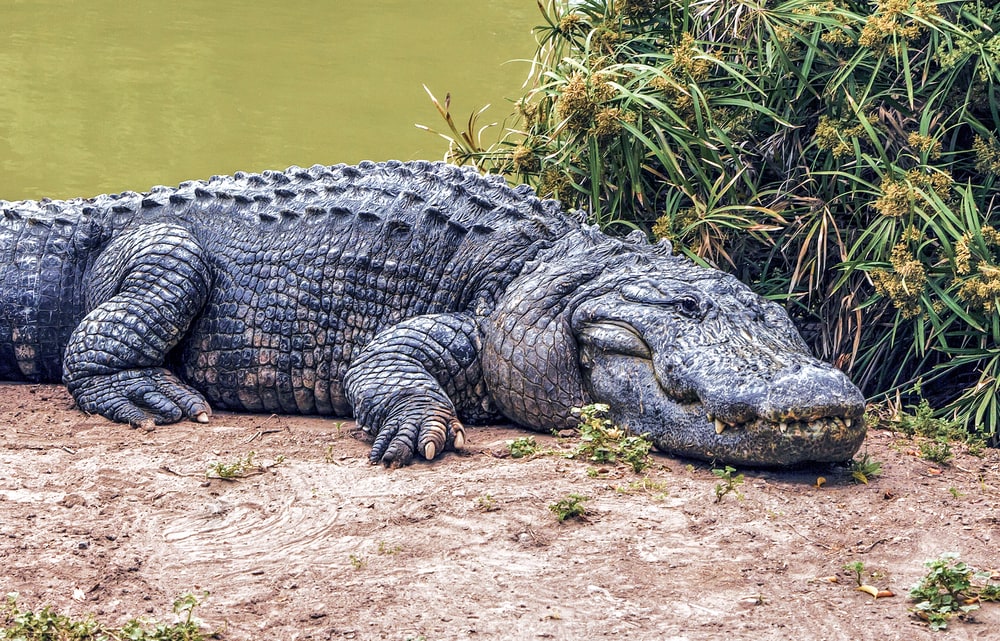
For a variety of reasons that we’ll explain later, there are plenty of alligators that are caught but not verified by the state. There are also plenty of eyewitness accounts that can’t be verified. Here is where we’ll discuss a few of those.
1| Apalachicola River, 2020
A man named Corey Capps spotted a massive alligator along the river behind his house just last year. According to the hunter, the animal had stalked him on fishing trips three times in the two months before he and a friend went out to hunt the animal.
The two harpooned the gator and spent three hours trying to move the massive animal from the river to the shore. The gator was taken to a recycling center in the town and was found to weigh 1,008 pounds (457 kilograms).
Reportedly the animal was over 13 feet (33 meters) in length, but the capture wasn’t verified by the Florida Fish and Wildlife Commission. You can read the full story here.
2| Okeechobee, 2016
A farm owner, his son, and three hunters got the surprise of their life in 2016 when they came across a massive alligator while hunting for hogs on their property. Reportedly, the massive alligator, pictured here, was around fifteen feet (4.5 meters) in length and weighed 780 pounds (354 kilograms).
Despite claims of the picture being fake, the posters claim it was a legitimate capture. The alligator was not verified by the Florida Fish and Wildlife Commission.
3| Apalachicola River, 2021
Towards the end of 2021, Ricky Banks and his son River were able to haul in a 13-foot (4 meters), 2-inch (5 centimeters) gator in the Apalachicola River. This one, though, had a sizable section of its tail bitten off earlier in its lifetime, so the true length of the alligator could have set a new record.
The hunters were unable to verify the gator’s weight either, as the scale they used broke down at 838 pounds (380 kilograms). Unfortunately, they weren’t able to wait on a biologist to come out and verify the length. According to the hunter, the animal was so big they couldn’t get it into a walk-in cooler to keep it from spoiling.
You can read the entire account from the hunter in this interview. The massive alligator took quite a few gunshots to finish off. The hunters plan to have it taxidermied and displayed for the general public.
Why Are Some Possible Record Alligators Not Certified?
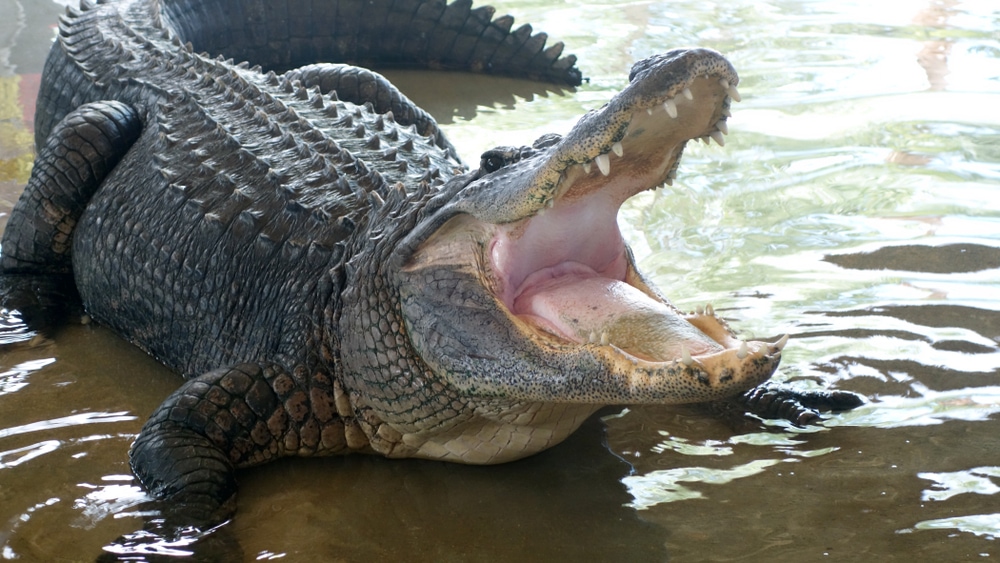
There are plenty of reasons why alligators aren’t certified by the FWC, and despite what some people think that doesn’t mean the numbers were exaggerated or it was a hoax.
For one, alligators spoil incredibly quickly after they die. In fact, state regulations for processing plants require butchering to begin within four hours of an alligator’s death. For hunters who plan to consume the animal, there simply isn’t enough time to wait on a state biologist.
Sometimes you have to pay to verify your record. Not every hunter can afford to do that, and combined with the short time frame for butchering the animal, it leads to some people ignoring state verification.
You could get around this by not immediately killing the alligator and transporting it alive. Even in theory though, this is incredibly dangerous and frankly stupid.
Some people do simply exaggerate claims. They take photos and post them as proof before disposing of the animal.
Other times, there simply isn’t anyone available to verify the alligator’s size.
Many places simply don’t have the equipment to get measurements, such as having a scale that can handle that much weight.
Just like with record hunts of other species, sometimes trying to fully verify the capture is just too much of a hassle for people. Especially when they weren’t record-hunting in the first place.
You may also like: Check Out These 25 Ferocious Types of Crocodiles From Around the Globe: Complete with Images, Facts, and More!
Could There Be Bigger Alligators Out There?
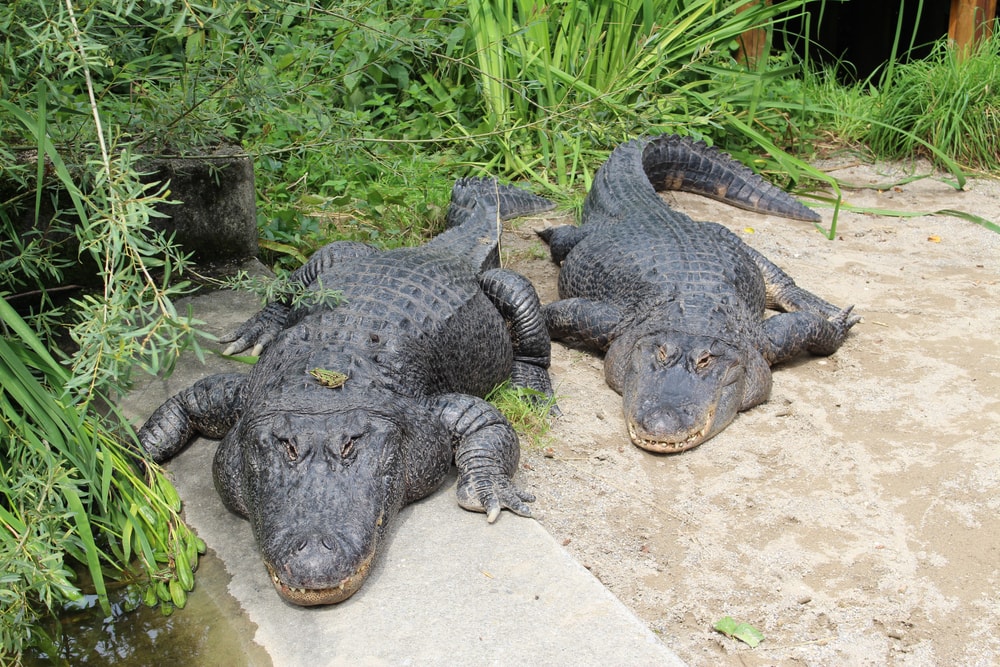
There could always be bigger gators out there. We know from keeping captive alligators that with enough food and space they can reach sizes of around fifteen feet (4.5 meters). In the wild, the chances are really slim, however, a literal freak of nature gator could feasibly get to sizes over fifteen feet (4.5 meters).
Even given that concession, the chance of a twenty-foot or larger alligator is essentially zero. With their slowed growth rate, high mortality rate, and a large amount of study put into how big they can get, finding a true “monster” alligator is pretty much impossible.
To put it simply, alligators just don’t grow that big.
You May Also Like: There Are 20 Sharks In Florida You Should Know About With Photos, Infographics, Facts, and more!
Legends of Giant Alligators in Florida
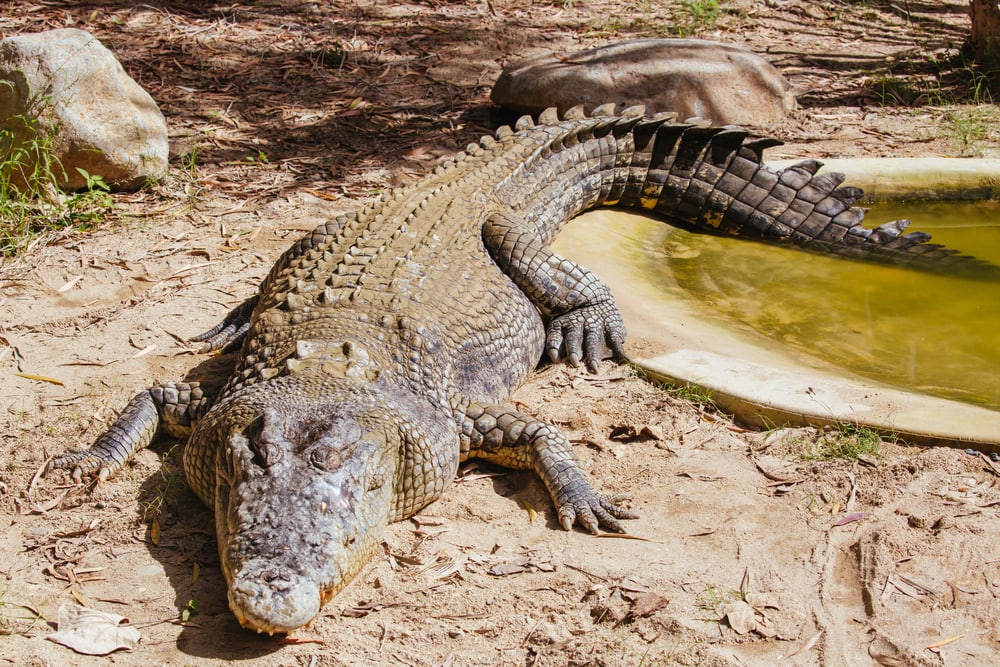
The records for alligator sizes in Florida only go back to the 1980s, mostly because that’s when harvesting programs were implemented by the FWC. Legends and stories of massive alligators go back for centuries, from Native American legends to sightings by field scientists.
Ned McIlhenny, a conservationist, came across what could be the largest alligator ever seen. In 1890, he came across a massive dying alligator and decided to put it out of its misery. Using his thirty-inch gun barrel, he came to the conclusion that the gator measured nineteen feet and two inches (5.8 meters and 5 centimeters).
The story was largely accepted because the man had a great reputation in the scientific community. The problem is that he brought home absolutely no evidence that the creature ever existed.
In the 1800s, a Lousianna game warden named Max Touchet killed a huge alligator. As it was too large to bring aboard the boat and they were several miles from land, they decided to skin the beast. Examinations of the skin put the alligator at 17-feet (5.18 meters) 10-inches (25.4 centimeters) in length.
The number is likely inaccurate. In fact, the animal was probably bigger, since alligator skin shrinks after being removed from the animal.
Some classic videos of massive alligators have come out in recent years. One in Polk County, Florida, seems to show a gator over fourteen feet (4.3 meters) and is deemed legitimate by biologists. Another video of a huge alligator walking across a Florida golf course is evidence of a 15-foot (0.38 meters), 1,000-pound (453 kilograms) animal frequenting the area.
You may also like: Check out the 10 Different Types of Sharks in Maui You Might Meet in Shore: Complete with Images, Facts, Descriptions, and More!
Alligator Hunting
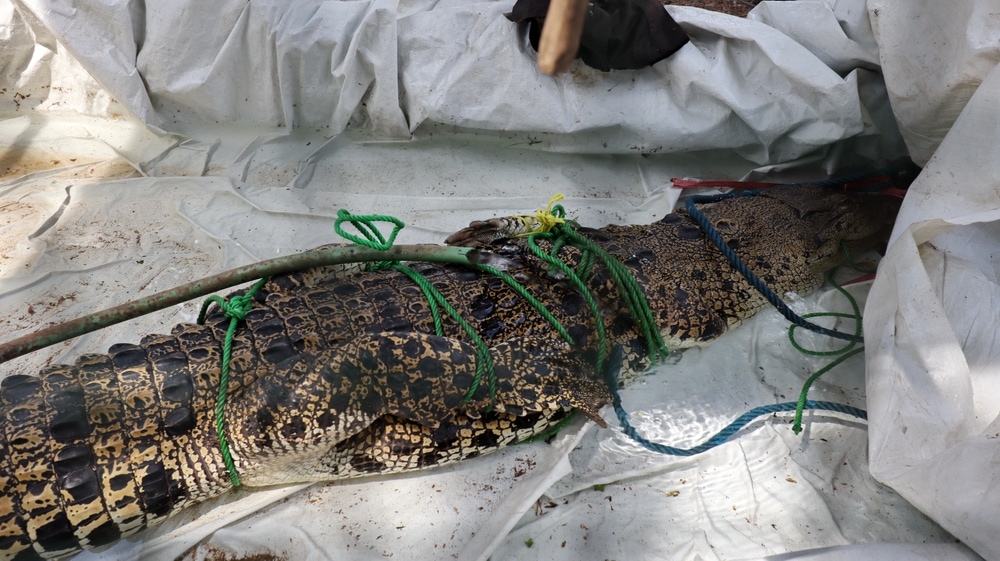
Alligator hunting is a part of much of the Southeast’s culture. The swamps of Florida and Lousianna are famous for it, even spawning shows like Swamp People on the History Channel.
In Florida, the FWC gives out around 7,000 tags each year in a lottery for the public. This is part of the statewide alligator harvest program, allowing hunters to take up to two adult gators each year.
The state also has a nuisance alligator harvest program. Alligators that have moved into urban environments pose a threat to people and pets, and the state sanctions certified hunters to trap and remove alligators from urban areas.
Human Interactions with Alligators in Florida
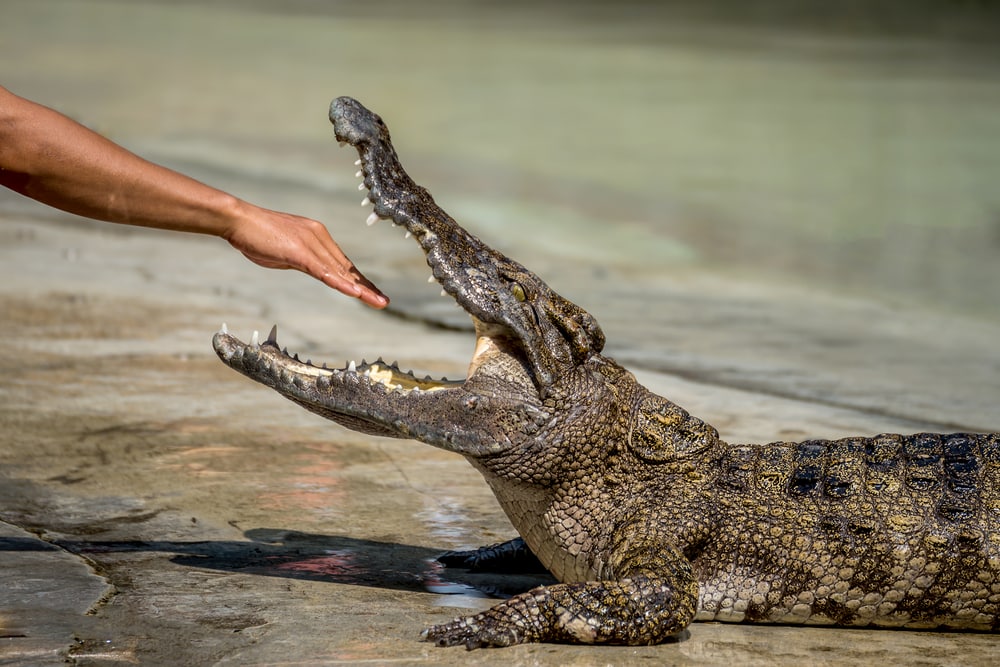
People and alligators have depended on the same lands and resources as long as they’ve lived in the same areas. It’s a conflict that humans win almost every time. In Florida, only seven unprovoked alligator attacks occur per year on average.
Alligators walking across a golf course, popping up in neighborhoods, and even being found in swimming pools aren’t unheard of.
This man found an alligator on his front lawn and used a trash can to trap it and keep it away from his family.
A funny side note, in public schools in Florida, they actually do teach you how to run from gators. Zig-zags are best because they can’t turn quickly, but they’re definitely faster than you in a straight line!
In most cases when they aren’t being threatened, alligators want nothing to do with people. They simply want to be left alone and largely ignore people when they aren’t too close.
You May Also Like: Wild Monkeys Is One Of The Invasive Animals In Florida. Discover These Wild Monkeys In Florida And How They Got There!
Threats to Alligator in Florida
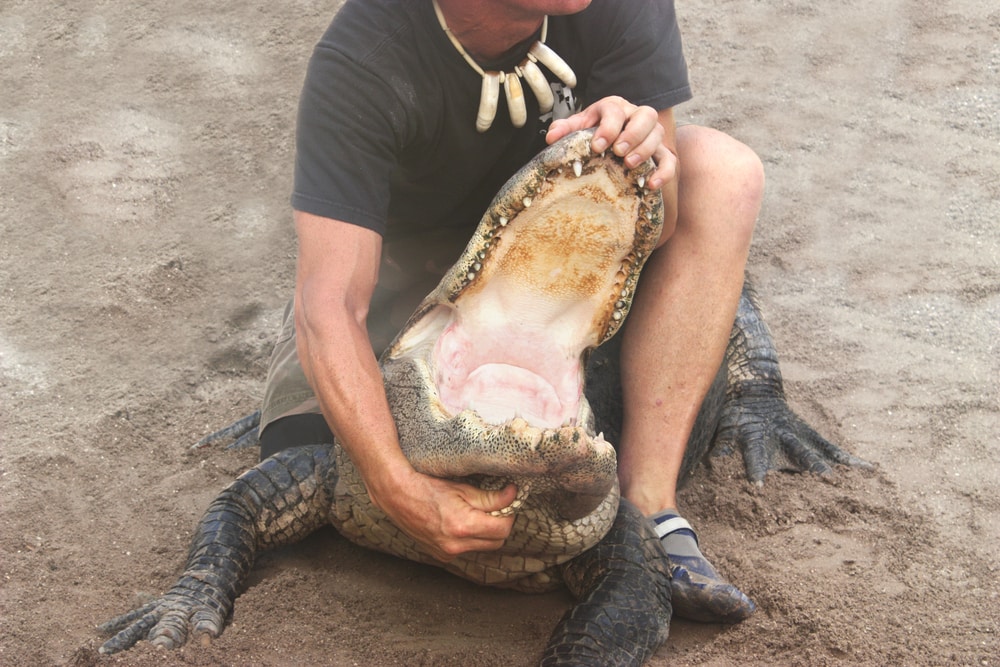
The biggest threat to alligators is humans. At one point, we had hunted the American Alligator to near extinction. Thanks to hunting regulations and pauses in hunting, the species is no longer endangered.
People hunt alligators for both their meat and skin, as the skin is desirable for leather clothing and accessories. Today, much of the demand for alligator products are filled by sustainable alligator farms. This gives the wild populations of alligators a lot of relief from hunters, with set regulations for the number of hunting tags given out each year based on population evaluations and more conscientious hunters taking care with which gators they harvest.
Habitat loss is a problem for alligators. As people expand, swamps are drained and rivers are dammed. Alligators are hardy and can adapt to human encroachment, but when they show up in canals behind homes or in urban areas, they’re deemed a threat and removed.
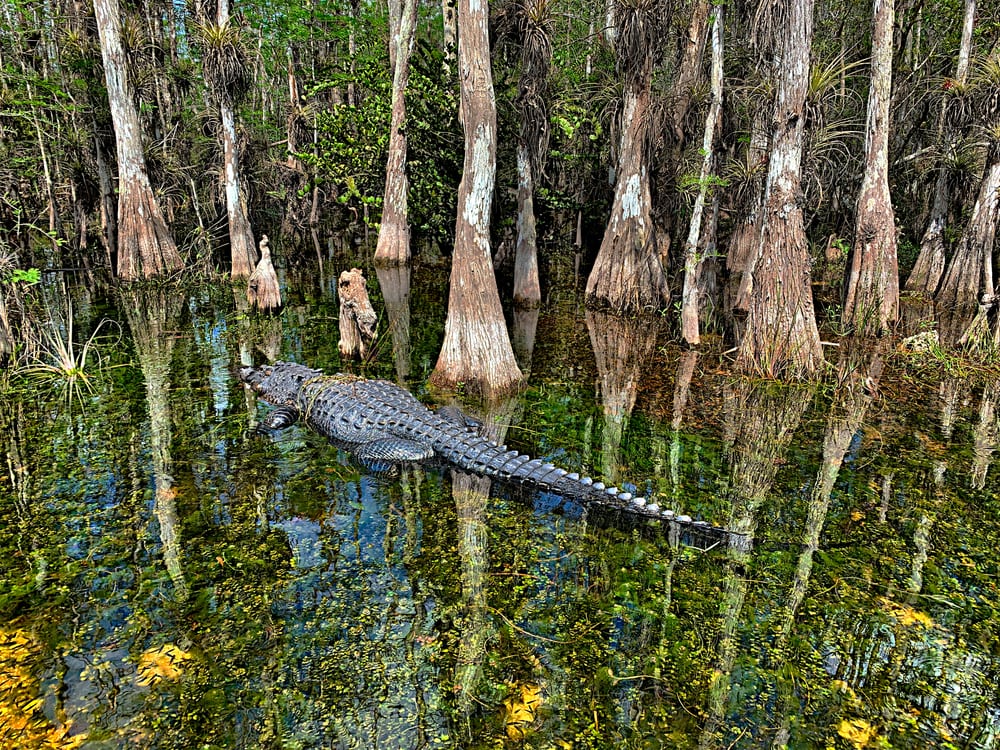
In many cases, gators are simply relocated. If the alligator is small enough to be captured and moved safely, they’re then released elsewhere. Big male alligators are more often killed when they’re a threat because capture and relocation are near impossible.
Populations of gators can become fragmented by human expansion as well. When their habitat is split up, they do have the ability to move between bodies of water. The problem is that in many cases, they’re moving through urban areas too close to people. When they get found in someone’s swimming pool, they get removed.
As global warming continues, the territory of alligators expands northward. On paper that sounds like a good thing for them, but a warming climate means higher body temperatures for them, requiring more food. It also affects much of their prey, leading to having less food available.
You may also like:
Discover different species found in Florida here:

Wild Monkeys In Florida | Poisonous Frogs In Florida | Anoles In Florida | Birds Of Florida | Vultures In Florida | Woodpeckers In Florida | Hawks In Florida | Florida Freshwater Fish | Florida Frogs | Scorpions In Florida | Geckos In Florida | Florida Spiders | Lizards In Florida | Owls In Florida | Florida Turtles | Snakes In Florida | Beach Birds Of Florida | Alligators In Texas | Sharks in Florida |









